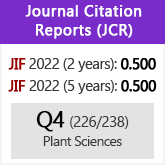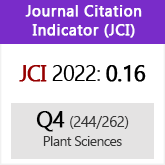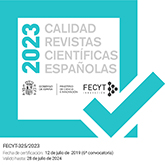Submerged macrophyte biomass distribution in the shallow saline lake Fuente de Piedra (Spain) as function of environmental variables
DOI:
https://doi.org/10.3989/ajbm.2305Keywords:
submerged macrophytes, eutrophication, lakes, maps, Fuente de Piedra, , SpainAbstract
Aquatic macrophyte biomass, diaspore bank distribution and their relationship to spatial variability of depth, nutrients (nitrite, nitrate, ammonium and soluble reactive phosphorus) as well as sediment granulometry in an athalassohaline lake have been studied during one wet hydrological year. The results indicate that species growing in the lake show different spatial distribution patterns throughout the lake. Indirect gradient analysis (canonical analysis) results showed a first axis defined as a function of Ulva flexuosa Wulfen biomass which is, in turn, positively correlated with interstitial ammonium and Soluble Reactive Phosphorus (SRP). The second axis was mainly established due to Lamprothamnium papulosum (Wallr.) J. Groves biomass which correlated positively to depth and negatively to interstitial ammonium and SRP. These results revealed a NESW eutrophic gradient allowing the U. Flexuosa biomass proliferation. This phenomenon could increase the shadow effect over the rest of the macrophytes inhabiting this shallow lake. Moreover, the eutrophic harmful effect on the macrophyte physiology and over the diaspore bank could have important consequences in the survival of such important populations. The results reported in this study show the need for studies as the base to select sampling points for monitoring this wetland.
Downloads
References
Acosta, L.W., Sabbatini, M.R., Fernández, O.A. & Burgos, M.A. 1999. Propagule bank and plant emergence of macrophytes in artificial channels of a temperate irrigation area in Argentina. Hydrobiologia 414: 1-5. http://dx.doi.org/10.1023/A:1003808713907
Anderson, M.J., Connell, S.D., Gillanders, B.M., Diebel, C.E., Blom, W.M., Saunders, J.E. & Landers, T.J. 2005. Relationships between taxonomic resolution and spatial scales of multivariate variation. Journal of Animal Ecology 74: 636-646. http://dx.doi.org/10.1111/j.1365-2656.2005.00959.x
Baker, M.E., Weller, D.E. & Jordan, T.E. 2006. Improved methods for quantifying potential nutrient interception by riparian buffers. Landscape Ecology 21(8): 1327-1345. http://dx.doi.org/10.1007/s10980-006-0020-0
Bayley, S.E. & Prather, C.M. 2003. Do wetland lakes exhibit alternative stable states? Submersed aquatic vegetation and chlorophyll in western boreal shallow lakes. Limnology and Oceanography 48(6): 2335-2345. http://dx.doi.org/10.4319/lo.2003.48.6.2335
Carter, V. & Rybicki, N. 1990. Light attenuation and submersed macrophyte distribution in the tidal Potomac River and estuary. Estuaries 13(4): 441-452. http://dx.doi.org/10.2307/1351788
Ceschin, S., Zuccarello, V. & Caneva, G. 2010. Role of macrophyte communities as bioindicators of water quality: Application on the Tiber River basin (Italy). Plant Biosystems 144(3): 528-536. http://dx.doi.org/10.1080/11263500903429221
Cirujano, S., Velayos, M., Castilla, F. & Gil, M. 1992. Criterios botánicos para la valoración de las lagunas y humedales españoles (Península Ibérica y las Islas Baleares). Colección Técnica ICONA. Madrid.
Comín, F.A., Herrera-Silveira, J.A. & Martín, M. 1994. Flamingo footsteps enhance nutrient release from the sediment to the water column. In: Faragó, S.A. & . Kerekes, J. J. (eds), Wetlands International Publicaton 43: 211-227. Sopron.
Conde-Álvarez, R.M. 2001. Variaciones espacio-temporales y ecofisiológicas de los macrófitos acuáticos de la laguna atalasohalina de Fuente de Piedra (Sur de la Península Ibérica). Universidad de Málaga.
Feldmann, T. & Nõges, P. 2007. Factors controlling macrophyte distribution in large shallow Lake Võrtsjärv. Aquatic Botany 87: 15-21. http://dx.doi.org/10.1016/j.aquabot.2007.01.004
Fernández, J.A., Niell, F.X. & Lucena, J. 1985. A rapid and sensitive automated determination of phosphate in natural water. Limnology and Oceanography 30(1): 227-230. http://dx.doi.org/10.4319/lo.1985.30.1.0227
Foden, J. 2007. Assessment metrics for littoral seagrass under the European Water Framework Directive; outcomes of UK intercalibration with the Netherlands. Hydrobiologia (579): 187-197. http://dx.doi.org/10.1007/s10750-006-0402-y
Forsberg, C. 1964. Phosphorus, a maximum factor in the growth of characeae. Nature 201: 517-518. http://dx.doi.org/10.1038/201517a0
Fraser, L.H. & Keddy, P.A. 2005. The world’s largest wetlands: Ecology and conservation. Cambridge University Press, Cambridge. http://dx.doi.org/10.1017/CBO9780511542091
García Jiménez, C. 1991. Estudio de un medio acuático fluctuante: la laguna atalasohalina de Fuente de Piedra (Málaga). Universidad de Málaga.
Glassom, D. & Branch, G.M. 1997. Impact of predation by greater flamingos Phoenicopterus ruber on the meiofauna, microflora, and sediment properties of two southern African lagoons. Marine Ecology Progress Series 149: 1-12. http://dx.doi.org/10.3354/meps149001
Grillas, P., García-Murillo, P., Geertz-Hansen, O., Marbá, N., Montes, C., Duarte, C.M., Tan Ham, L. & Grossmann, A. 1993. Submerged macrophyte seed bank in a Mediterranean temporary marsh: abundance and relationship with established vegetation. Oecologia 94: 1-6. http://dx.doi.org/10.1007/BF00317293
Irfanullah, H. & Moss, B. 2004. Factors influencing the return of submerged plants to a clear-water, shallow temperate lake. Aquatic Botany 80: 177-191. http://dx.doi.org/10.1016/j.aquabot.2004.07.010
Kinney, E. & Roman, C. 1988. Response of primary producers to nutrient enrichment in a shallow estuary. Marine Ecology Progress Series 163: 89-98. http://dx.doi.org/10.3354/meps163089
Legendre, P. & Legendre, L. 1998. Numerical Ecology. Elsevier, Amsterdam. Martín, J. 1999. Desarrollo y aplicación del nuevo catálogo de especies amenazadas de la comunidad de Castilla-La Mancha. Conservación Vegetal 4: 5-6.
Martínez-Taberner, A. & Moya, G. 1991. Water chemistry tolerance of charophytes in a Mediterranean coastal marsh. Nova Hedwigia 52: 1-2.
McElarney, Y.R. & Rippey, B. 2009. A comparison of lake classifications based on aquatic macrophytes and physical and chemical water body descriptors. Hydrobiologia 625: 195-206. http://dx.doi.org/10.1007/s10750-009-9708-x
Moe, S.J., Dudley, B. & Ptacnik, R. 2008. REBECCA databases: experiences from compilation and analyses of monitoring data from 5,000 lakes in 20 European countries. Aquatic Ecology 42: 183-201. http://dx.doi.org/10.1007/s10452-008-9190-y
Moss, B. 1990. Engineering and biological approaches to the restoration from eutrophycation of shallow lakes in which aquatic plant communities are important components. Hydrobiologia 200-201: 367-378. http://dx.doi.org/10.1007/BF02530354
Penning, W.E., Dudley, B., Mjelde, M., Hellsten, S., Hanganu, J., Kolada, A., van den Berg, M., Poikane, S., Phillips, G., Willby, N. & Ecke, F. 2008a. Using aquatic macrophyte community indices to define the ecological status of European lakes. Aquatic Ecology 42: 253-264. http://dx.doi.org/10.1007/s10452-008-9183-x
Penning, W.E., Mjelde, M., Dudley, B., Hellsten, S., Hanganu, J., Kolada, A., van den Berg, M., Poikane, S., Phillips, G., Willby, N. & Ecke, F. 2008b. Classifying aquatic macrophytes as indicators of eutrophication in European lakes. Aquatic Ecology 42: 237-251. http://dx.doi.org/10.1007/s10452-008-9182-y
Pérez-Ruzafa, A., Marcos, C., Pérez-Ruzafa, I.M., Barcala, E., Hegazi, M.I. & Quispe, J. 2007. Detecting changes resulting from human pressure in a naturally quick-changing and heterogeneous environment: Spatial and temporal scales of variability in coastal lagoons. Estuarine, Coastal and Shelf Science 75: 175-188. http://dx.doi.org/10.1016/j.ecss.2007.04.030
Perrow, M.R., Moss, B. & Stansfield, J. 1994. Trophic interactions in a shallow lake following a reduction in nutrient loading: a long-term study. Hydrobiologia: 43-52. http://dx.doi.org/10.1007/BF00026698
Pokorny, J. & Kevět, J. 2004. Aquatic Plants and lake Ecosystem. In: Patrick E. O’Sullivan & Colin, S., The Lakes Handbook: Limnology and limnetic ecology: 309-340. Blackwell Publishing Maldel (USA).
Porta, J. 1986. Técnicas y experimentos en edafología. Colegi oficial d'Enginyers Agrònomos de Catalunya, Barcelona.
Ramsar. 2007. Inventory, assessment, and monitoring: An Integrated Framework for wetland inventory, assessment, and monitoring. Ramsar handbooks for the wise use of wetlands, 3rd edition, vol. 11. Ramsar Convention Secretariat, Gland, Switzerland.
Rosenberg, M.S., & Anderson, C.D. 2011. PASSaGE: Pattern Analysis, Spatial Statistics and Geographic Exegesis. Version 2. Methods in Ecology and Evolution 2(3): 229-232. http://dx.doi.org/10.1111/j.2041-210X.2010.00081.x
Santamaría, L., Dias, C. & Hootsmans, M. 1994. The influence of ammonia on the growth and photosynthesis of Ruppia drepanensis Tineo from Doñana National Park (SW Spain). Hydrobiologia 276(2): 219-231.
Santamaría, L. Montes, C. & Hootsmans, M.J.M. 1996. Influence of environmental parameters on the biomass development of Ruppia drepanensis populations in Doñana National Park: The importance of conditions affecting the underwater light climate. International Journal of Salt Lake Research 5: 157-180. http://dx.doi.org/10.1007/BF01995828
Santamaría, L. & Vierssen, W.V. 1995. Predicting the impacf of eutrophication stress on the survival of submerged vegetation in shallow temporaly lakes. 6th International Conference on the conservation and management of lakes and reservoirs: 777-780.
Schutten, J., Dainty, J. & Davy, A.J. 2005. Root anchorage and its significance for submerged plants in shallow lakes. Journal of Ecology 93(3): 556-571. http://dx.doi.org/10.1111/j.1365-2745.2005.00980.x
Selig, U., Schubert, M., Eggert, A., Steinhardt, T., Sagert, S. & Schubert, H. 2007. The influence of sediments on soft bottom vegetation in inner coastal waters of Mecklenburg-Vorpommern (Germany). Estuarine Coastal and Shelf Science 71: 241-249. http://dx.doi.org/10.1016/j.ecss.2006.07.015
Shinn, M.B. 1945. A colorimetric method for the determination of nitrite. Industrial and Engineering Chemistry, Analytical Edition 13: 33-35. http://dx.doi.org/10.1021/i560089a010
Slawyk, G. & MacIsaac, J.J. 1972. Comparison of two automated ammonium methods in a region of coastal upwelling. Deep-Sea Research 19: 521-524.
Sokal, R.R. & Rohlf, F.J. 1995. Biometry. Freeman & Company, New York.
Søndergaard, M., Jeppesen, E., Lauridsen, T., Skov, C., Van Nes, E., Roijackers, R., Lammens, E. & Portielje, R. 2007. Lake restoration successes, failures and long-term effects. Journal of Applied Ecology 44: 1095-1105. http://dx.doi.org/10.1111/j.1365-2664.2007.01363.x
Søndergaard, M., Johansson, L.S., Lauridsen, T.L., Jørgensen, T.B., Liboriussen, L. & Jeppesen, E. 2010. Submerged macrophytes as indicators of the ecological quality of lakes. Freshwater Biology 55: 893-908. http://dx.doi.org/10.1111/j.1365-2427.2009.02331.x
Turner, R.K., van den Bergh, J.C.J.M., Söderqvist, T., Barendregt, A., van der Straaten, J., Maltby E. & van Ierland, E.C. 2000. Ecological-economic analysis of wetlands: scientific integration for management and policy. Ecological Economics 35: 7-23. http://dx.doi.org/10.1016/S0921-8009(00)00164-6
Vargas, J.M., Blasco, M. & Antúnez, A. 1983. Los vertebrados de la laguna de Fuente de Piedra (Málaga). Monografías ICONA 28: 1-228.
Wijck, C.P., Grillas, C.J. & de Groot, L.T. 1994. A comparison between the biomass production of Potamogeton pectinatus L. and Myriophyllum spicatum L. in the Camargue (southern France) in relation to salinity ans sediment characteristics. Vegetatio 113: 171-180.
Wood, E.D., Armstrong, F.A.J. & Richards, F.A. 1967. Determination of nitrate in sea water by cadmium-copper reduction to nitrite. Journal of the Marine Biological Association 47: 23-31. http://dx.doi.org/10.1017/S002531540003352X
Downloads
Published
How to Cite
Issue
Section
License
Copyright (c) 2012 Consejo Superior de Investigaciones Científicas (CSIC)

This work is licensed under a Creative Commons Attribution 4.0 International License.
© CSIC. Manuscripts published in both the printed and online versions of this Journal are the property of Consejo Superior de Investigaciones Científicas, and quoting this source is a requirement for any partial or full reproduction.All contents of this electronic edition, except where otherwise noted, are distributed under a “Creative Commons Attribution 4.0 International” (CC BY 4.0) License. You may read here the basic information and the legal text of the license. The indication of the CC BY 4.0 License must be expressly stated in this way when necessary.
Self-archiving in repositories, personal webpages or similar, of any version other than the published by the Editor, is not allowed.

















